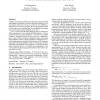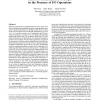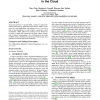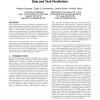153
click to vote
ICFP
2012
ACM
12 years 8 months ago
2012
ACM
Graphics processing units (GPUs) provide both memory bandwidth and arithmetic performance far greater than that available on CPUs but, because of their Single-Instruction-Multiple...
122
click to vote
MICRO
2012
IEEE
12 years 8 months ago
2012
IEEE
This article presents a general algorithm for transforming sequential imperative programs into parallel data-flow programs. Our algorithm operates on a program dependence graph i...
PLDI
2012
ACM
12 years 8 months ago
2012
ACM
Software-based thread-level parallelization has been widely studied for exploiting data parallelism in purely computational loops to improve program performance on multiprocessors...
PPOPP
2012
ACM
13 years 1 months ago
2012
ACM
The actor model has already proven itself as an interesting concurrency model that avoids issues such as deadlocks and race conditions by construction, and thus facilitates concur...
SIGMOD
2011
ACM
13 years 9 months ago
2011
ACM
In this demonstration we present BRRL, a library for making distributed main-memory applications fault tolerant. BRRL is optimized for cloud applications with frequent points of c...
PROCEDIA
2011
13 years 9 months ago
2011
A new challenge in scientific computing is to merge existing simulation models to create new higher fidelity combined (often multi-level) models. While this challenge has been a...
PLDI
2011
ACM
13 years 9 months ago
2011
ACM
For more than thirty years, the parallel programming community has used the dependence graph as the main abstraction for reasoning about and exploiting parallelism in “regular�...
PLDI
2011
ACM
13 years 9 months ago
2011
ACM
MATLAB is an array language, initially popular for rapid prototyping, but is now being increasingly used to develop production code for numerical and scientific applications. Typ...
JPDC
2011
13 years 9 months ago
2011
Scripting languages such as R and Matlab are widely used in scientific data processing. As the data volume and the complexity of analysis tasks both grow, sequential data process...
BCB
2010
14 years 1 months ago
2010
Many biologically motivated problems are expressed as dynamic programming recurrences and are difficult to parallelize due to the intrinsic data dependencies in their algorithms. ...




